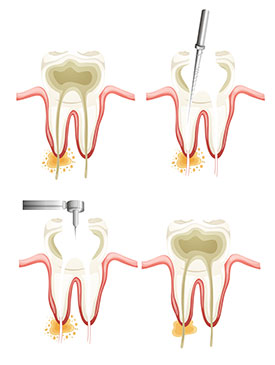Root Canals
How do you spell relief? Well, if you’ve ever had a major infection that’s reached the roots of your tooth, relief probably meant R-O-O-T-C-A-N-A-L. A root canal can help get you out of pain and can prevent the need for a tooth extraction.
For the most part, root canals are successful — and your dental treatment may last a lifetime. But for the five percent of root canals that don’t heal, endodontic retreatment is often necessary to save the tooth.
What’s the Point?
Endodontic therapy is a complicated procedure that uses files to extract infected pulp from the root.
When the infection remains in the root’s canals, the tooth may not heal, causing it to become reinfected. There are several ways this can happen:

Make Appointment
That’s How You Know
Many dental patients experience some discomfort as their tooth heals following a dental procedure — so how will you know if your root canal requires endodontic retreatment?
Discomfort that does not go away within a couple of days or an increase in pain could be signs that your root canal is reinfected. If the toothache remedies prescribed by your dentist don’t give you any relief, it may be also be a sign of a problem.
You may not experience symptoms right away — a failed root canal can happen months or even years after the original procedure is performed. If the infection travels to the bone, a dental abscess can form, causing swelling in the gums.
Your dentist will take an X-ray of your tooth to diagnose any dental problems and determine whether you need endodontic retreatment.
